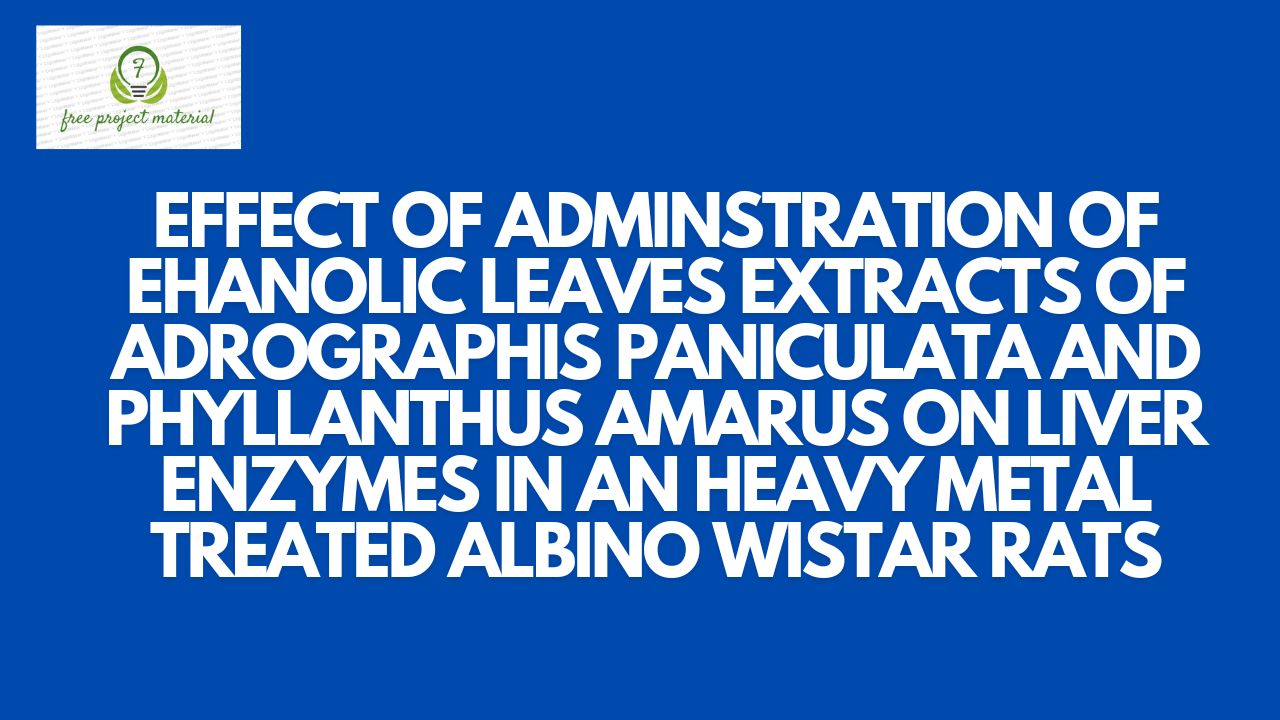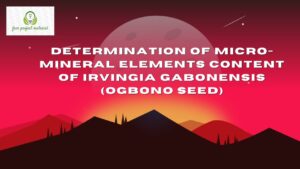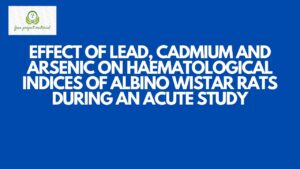ABSTRACT
The effect of administration of ethanol leave extracts of Andrographis paniculata and Phyllanthus amarus on serum liver enzymes in albino wistar rats treated with cadmium was investigated. Twenty five (25) male rats (130-170g) were randomly assigned five groups of five animals each. Group 1,2,3 and 4 were treated with 30% of LD50 of cadmium (224.8) each. Group 1 was further administered with 400mg/kg of Andrographis paniculata and Phyllanthus amarus at 50:50 dosage ratio. Group 2 and 3 were administered with 400mg/kg of Phyllanthus amarus and Andrographis paniculata respectively. Group 5 was neither treated with cadmium no administered with the plants extracts and was taken as control. Each of the group was fed with commercial rat mash and distilled water for three weeks of extract administration. The result revealed no significant difference in mean serum ALP and AST in the treated groups when compare to the control (p>0.05). No significant difference was also found among the treated groups (p>0.05). This results implies that the two plants extract combine and single had the efficacy to suppress the cadmium toxicity that would have resulted in an assault on the liver leading to linkages of the liver enzymes into blood circulation thereby resulting in their elevated concentrations in the serum.
TABLE OF CONTENTS Pages
TITLE PAGE – – – – – – – i
CERTIFICATION – – – – – – ii
DEDICATION – – – – – – – iii
ACKNOWLEDGEMENTS – – – – – iv
ABSTRACT – – – – – – – v
TABLE OF CONTENTS – – – – – vi-ix
CHPATER ONE: INTRODUCTION
1.1 Background of the Study – – – –
1.2 Aim and objectives of the Study – – –
1.3 Scope and Limitations of the study – – –
CHAPTER TWO: LITERATURE REVIEW
2.1 Description of the Plant – – – – –
2.1.1 Description of A. paniculata Plant – – – –
2.1.2 Description of P. amarus Plant – – – –
2.2 Origin and Classification of the Plants – – –
2.2.1 Origin and Classification of A. paniculata Plant – –
2.1.2 Origin and Classification of P. amarus Plant – –
2.3 Phytochemicals Present in the Plant – – – –
2.3.1 Phytochemicals present in A. paniculata Plant – –
2.3.2 Phytochemical Present in P. amarus Plant – – –
2.4 Medicinal Uses of the Plant – – – – –
2.4.1 Medicinal Uses of A. paniculata Plant – – –
2.4.2 Medicinal Uses of P. amarus Plant – – – –
2.5 Effect of Heavy Metal Toxicity – – – –
2.6 The Role of Liver Enzymes in the Body System – –
CHAPTER THREE: MATERIAL AND MEHODS
3.1 Materials and Reagents Used – – – – –
3.1.1 Collection of Plant Samples – – – – –
3.1.2 Preparation of Plant Samples – – – – –
3.1.3 Experimental Design, Grouping and Treatment
of Animals – – – – – – – –
3.1.4 Collection of Blood Samples and Preservation
of Serum – – – – – – – –
3.2 Methods – – – – – – – –
3.2.1 Determination of Serum Level of Alkaline
Phosphatase (ALP) – – – – – –
3.2.2 Determination of Serum level of Alanine
Transaminase (ALT) – – – – – –
3.2.3 Determination of Serum Level of Aspartate
Aminotransferase (AST) – – – – –
CHAPTER FOUR: RESULTS AND CONCLUSION
4.1 Results – – – – – – – –
4.2 Discussion – – – – – – – –
CHAPTER FIVE: CONCLUSION AND RECOMMENDATIONS
5.1 Conclusion – – – – – – –
5.2 Recommendation – – – – – – –
References
CHAPTER ONE: INTRODUCTION
1.1 Background of the Study
Medicinal plants is an integral part of human life to combat the sufferings from the dawn of civilization. (Chaudhary, 2010). It is estimated that more than 5000 of total plant species have been identified and used as medicinal plant around the world (Joy et al., 1998). Among these plants, more than 1300 plants species have been used traditionally in Malaysia where the knowledge is being passed down from generation to generation (Burkill et al., 2000). The indigenous medicinal plants and plant derived drugs are the potential source of alternative medicine and are extensively used to treat various health ailments (Kavishankan, 2011). Use of the medicinal plants is a core components at primary health care level due to availability and affordability. Dependency on these medicinal plants varies from country to country. It is estimated that about 75-80% of people of developing countries and about 25% of people of developed countries depend either directly or indirectly on medicinal plants for the first line of treatment (Burkiu et al., 2000; Hajiaghaee and Akhondzadeh, 2012). Therefore, people are encouraging indigenous product and processing of these medicinal plants to use in different cultures and religion for the treatment of various disease. Moreover, importance and uses of medicinal plants are also stated in different religious books (i.e., the Holy Bible, the Quran). About 19 medicinal plants and 176 medicinal plants are mentioned in the Holy Bible (Duke, 2007) and the Holy Quran (Urbi et al., 2014), respectively.
Andrographis paniculata is important medicinal plants and widely used around the world. It belongs to the family Acanthaceae, comprises of about 40 species. Andrographis paniculata, commonly known as King of bitters running half to one meter in height. Andrograhpis panoculata used as a traditional herbal medicine in Bangladesh, China, Hong Kong, India, Pakistan, Philippines, Malaysia, Indonesia and Thailand (Akbar, 2011; Kabir et al., 2014). And is enthnobotanically used for the treatment of snake bite, bug bite, diabetes, dysentery, fever and malaria (Burkkill, 2000). However, the preparations yet needs to be standardized for their bitter efficacy. The aerial parts of Andrographis paniculata is most commonly used; its extracts contain diterpenoids, diterpene glycosides, lactones flavonoids and flavonoid glycosides. Whole plant leaves and rot are also used as a folklore remedy for different diseases in Asia and Europe (Akbar, 2011). Andrographis has been reported to have a broad range of pharmacological effects including anticancer (Ajaya et al., 2004; Rajafopal, 2003) antidiarrheal (Gupta et al., 2009; Gupta and Yadava, 1993) antihepatitis (Sharma et al., 1991), anti-HIV (Narduri et al., 2004), antihyperglycemic (Yu et al., 2003), anti- inflammatory (Chliou and Chen, 1998), antimicrobial, antimalarial (Wilat et al., 2005), antioxidant (Singh et al., 1995), immunostimulatory (Calabrese et al., 2000) and sexual dysfunction (Akbarsha and Murugaian, 2000).
Phyllanthus amarus is a broad spectrum medicinal plant that has received world-wide recognition (Sruidiya and Perival, 1995). In Nigeria it is called “Oyomokeisoamankedem” in Efik “Iyin olobe”, in Yoruba and “Ebebenizo: in Bini (Etta, 2008). Phyllanthus amarus is generally employed to reduce pain, expel intestinal gas, to stimulate and promote digestion and ati-helmithes to expel intestinal worms and acts as a mild laxative. Phyllanthus amarus also has antiseptic, diuretic, antiviral, antidiabetic, hypotensive and antipyreric properties and also used in the treatment of jaundice, diarrhea, dysentery, wound, ulcers and urogenital diseases (Calixto et al., (1998); Santos et al., 1995). It can also be use to treat chronic liver disease (Liu and Huang, 2003).
Liver play a central role in transforming and clearing chemicals and is susceptible to the toxicity from these agents. Certain medicinal agents, when introduced with therapeutic ranges may injure the organ .Other chemical agents such as those used in laboratory and industries, natural chemicals (heavy metals and herbal remedies can also induce hepatotoxicity (Friedman et al., 2003).
1.2 Aim And Objectives Of The Study
Aim of the Study
The aim of this research work was to determine the effect of administration of ethanolic leaves extracts of Andrographis panuculata leaves and Phyllanthus amarus leaves on liver enzymes in an heavy metal treated albino wister rats.
Objectives of the Study
The following were the objectives of this works:
i To determine the serum level of alkaline phosphatase (ALP) in rats administered with Adrographis paniculata leaves and Phyllanthus amarus and treated with cadmium.
ii To determine the serum levels of alanine transaminase (ALT) in an heavy metal treated rat co-administered with Andrographis paniculata leaves and Phyllanthus amarus and treated with cadmium.
Iii To determine the serum level of aspartate amino transaminase (AST) in an heavy metal rat co-administered with Andrographis paniculata leaves and Phyllanthus amarus leaves and treated with cadmium.
1.3 Scope and Limitations of the Study
The scope of this study covered the determination of serum level of ALP, ALT and AST in albino wister rats co-administered with ethanolic extract of Andrographis paniculata leaves and Phyllanthus amarus leaves in an heavy metal treated albino Wister rats. However, lack of facilities, high cost of materials, limited time and financial constraint were the limitations of this research work.



